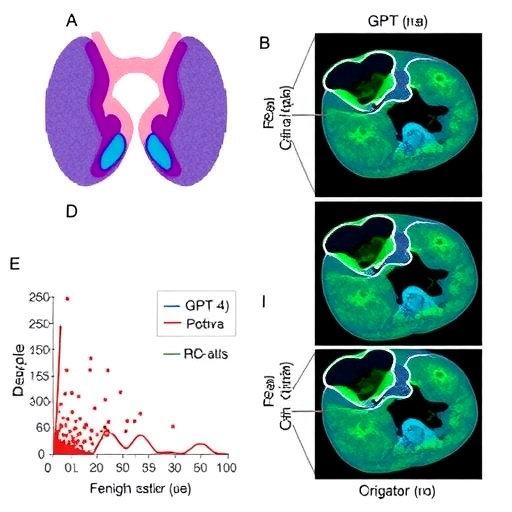
In a groundbreaking study soon to be published, researchers led by Wang et al. have unveiled critical insights into the mechanisms driving pulmonary fibrosis, a debilitating condition that currently lacks effective therapeutic options. Their investigation centers on the molecular dynamics of caspase-9, a cysteine protease traditionally understood for its role in apoptosis, or programmed cell death. This exploration has revealed an unforeseen function of caspase-9âactivating β-catenin signaling pathways that are pivotal in the progression of pulmonary fibrosis.
Pulmonary fibrosis is characterized by the relentless scarring of lung tissue, which can lead to severe respiratory dysfunction. The complexity of this disease is compounded by the fact that its etiology is often idiopathic, meaning the exact causes remain elusive. While environmental factors and genetic predispositions are known to contribute to its development, the precise cellular mechanisms underlying the fibrotic process are still being unraveled. The revelations from Wang’s team are poised to add a significant piece to this intricate puzzle.
The study meticulously details how caspase-9, with its established role in apoptosis, also interfaces with the β-catenin signaling pathway. This pathway, known for its involvement in cell proliferation and differentiation, has been implicated in the pathogenesis of various fibrotic diseases. Wang et al. utilized a variety of experimental models, including in vitro cell cultures and in vivo animal models, to delineate the relationship between caspase-9 and β-catenin in the context of pulmonary fibrosis.
In their experiments, the researchers noted that inhibition of caspase-9 led to a marked reduction in β-catenin activity, which consequently resulted in decreased fibroblast proliferation and reduced extracellular matrix depositionâtwo hallmarks of fibrotic disease. These findings suggest a paradigm shift in our understanding of caspase-9, potentially recasting it from merely a pro-apoptotic factor to a critical player in fibrotic signaling. This observation opens up new avenues for therapeutic intervention.
In particular, the research highlights the potential for targeting caspase-9 not only to modulate cell death but also to alter the fibrotic response. This dual functional role could lead to a more nuanced approach in treating pulmonary fibrosis, where therapies may aim to balance the apoptotic and fibrogenic signals within the lung tissue. By strategically manipulating these pathways, it might be possible to halt or even reverse some of the scarring associated with the disease.
The impact of this discovery extends beyond mere academic interest; it has profound implications for clinical practice. With current treatments for pulmonary fibrosis focusing primarily on managing symptoms and slowing disease progression, targeting the underlying molecular mechanisms offers a promising new strategy. The teamâs insights could pave the way for novel drug development aimed specifically at modulating the activity of caspase-9 or β-catenin.
Further studies will be required to fully elucidate the mechanisms by which caspase-9 activates β-catenin signaling and to determine the therapeutic window for any potential interventions. Nevertheless, this research illuminates a crucial intersection between apoptosis and fibrosis that had previously remained obscure. To that end, Wang et al. are advocating for a more integrated understanding of cellular signaling networks in the context of lung diseases.
This potential therapeutic approach will require rigorous clinical trials to assess both efficacy and safety in human populations. The complexity of human biology, variations in disease presentations, and patient responses underscore the necessity for a comprehensive and nuanced approach to clinical testing. As the research community rallies to address these challenges, the findings from this study could become a cornerstone for the future of pulmonary fibrosis treatment.
The implications of this research are further underscored by the growing global burden of pulmonary diseases. With rising incidences of conditions like idiopathic pulmonary fibrosis, a deeper understanding of the underlying biology is more essential than ever. Establishing a clear link between caspase-9 and β-catenin not only enriches our scientific knowledge but also highlights the immediate need for innovative therapies that can change the trajectory of this devastating disease.
This study serves as a testament to the power of interdisciplinary research. By combining molecular biology, biochemistry, and clinical science, Wang and colleagues have illuminated a pathway that connects fundamental cellular processes with a complex disease state. Their work exemplifies the importance of viewing scientific challenges through multiple lenses and the potential that lies in such collaborative approaches.
As the research landscape continues to evolve, the findings from Wang’s study will likely spark further inquiries into the multifaceted roles of apoptotic pathways in various fibrotic conditions beyond the lungs. For instance, similar mechanisms may be at play in liver, kidney, or cardiac fibrosis, suggesting that the insights gained could have far-reaching implications across fields.
Ultimately, the task ahead involves translating pathway modulation into tangible clinical outcomes. Moving from bench to bedside will require not only advanced pharmacological interventions but also robust engagement with regulatory frameworks to expedite the availability of new therapies to patients in dire need. The pursuit of new treatment modalities for pulmonary fibrosis, as highlighted by the work of Wang et al., stands as a pressing imperative for the medical community.
In conclusion, this forthcoming research articulates an inspiring narrative of scientific inquiry that underscores the need for a re-examination of long-held beliefs regarding apoptosis and its role in disease. By establishing the link between caspase-9 and β-catenin signaling in pulmonary fibrosis, this study lays the groundwork for future therapeutic innovations that could significantly alter the landscape of treatment for patients suffering from this challenging and often devastating condition.
Subject of Research: The role of caspase-9 in activating β-catenin signaling in pulmonary fibrosis.
Article Title: Caspase-9 activates β-catenin signaling to promote pulmonary fibrosis.
Article References:
Wang, J., Qing, B., Gu, L. et al. Caspase-9 activates β-catenin signaling to promote pulmonary fibrosis.
J Transl Med 23, 986 (2025). https://doi.org/10.1186/s12967-025-07020-1
Image Credits: AI Generated
DOI:
Keywords: pulmonary fibrosis, caspase-9, β-catenin, apoptosis, fibroblast proliferation, extracellular matrix deposition, therapeutic intervention.
Tags: apoptosis and fibrosis connectionCaspase-9 and pulmonary fibrosiscellular mechanisms of fibrosisenvironmental factors in pulmonary fibrosisgenetic predispositions in lung fibrosisidiopathic pulmonary fibrosis researchlung tissue scarring processesmechanisms of lung fibrosisnovel insights into fibrotic diseasesrole of cysteine proteases in diseasetherapeutic options for lung diseasesβ-catenin signaling pathway activation




